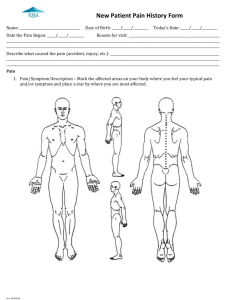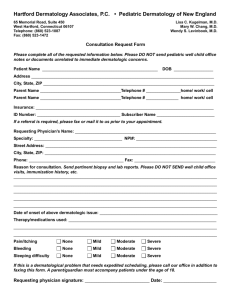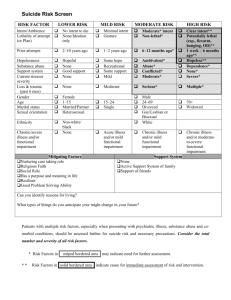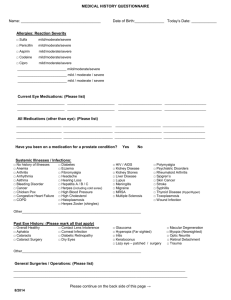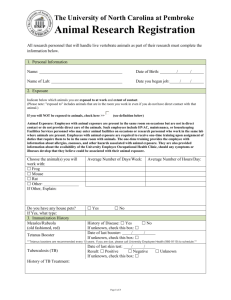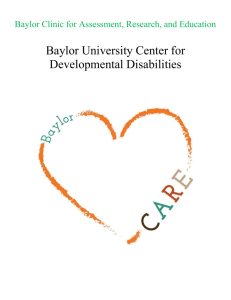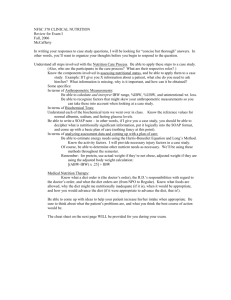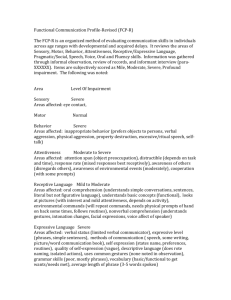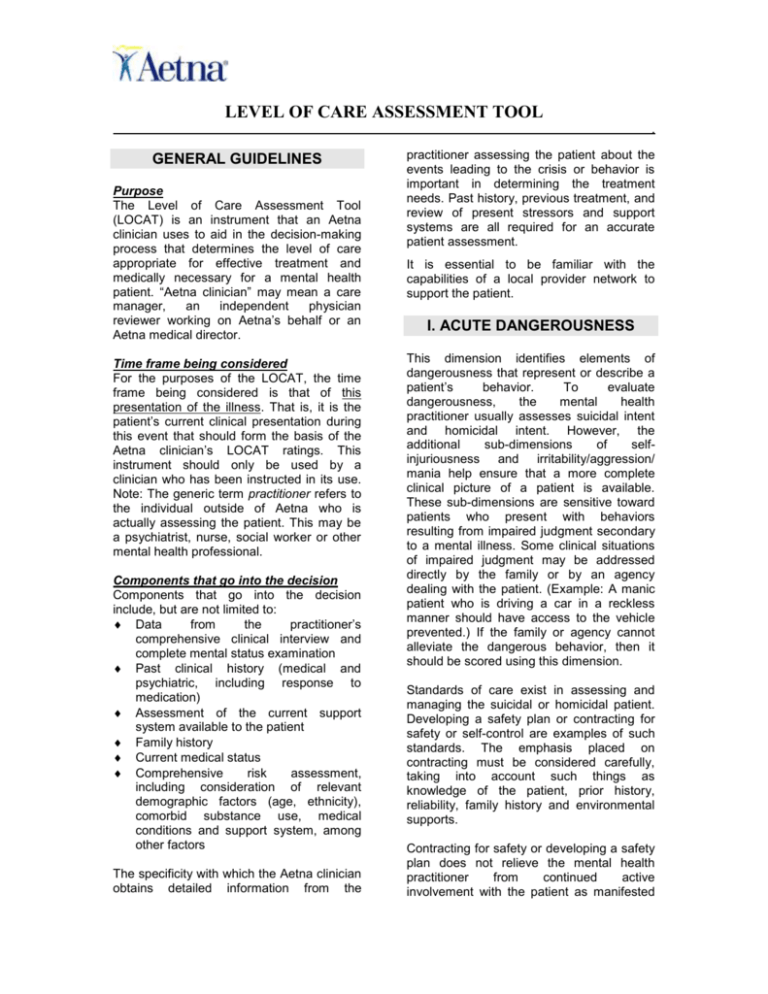
LEVEL OF CARE ASSESSMENT TOOL
.
GENERAL GUIDELINES
Purpose
The Level of Care Assessment Tool
(LOCAT) is an instrument that an Aetna
clinician uses to aid in the decision-making
process that determines the level of care
appropriate for effective treatment and
medically necessary for a mental health
patient. “Aetna clinician” may mean a care
manager,
an
independent
physician
reviewer working on Aetna’s behalf or an
Aetna medical director.
Time frame being considered
For the purposes of the LOCAT, the time
frame being considered is that of this
presentation of the illness. That is, it is the
patient’s current clinical presentation during
this event that should form the basis of the
Aetna clinician’s LOCAT ratings. This
instrument should only be used by a
clinician who has been instructed in its use.
Note: The generic term practitioner refers to
the individual outside of Aetna who is
actually assessing the patient. This may be
a psychiatrist, nurse, social worker or other
mental health professional.
Components that go into the decision
Components that go into the decision
include, but are not limited to:
Data
from
the
practitioner’s
comprehensive clinical interview and
complete mental status examination
Past clinical history (medical and
psychiatric, including response to
medication)
Assessment of the current support
system available to the patient
Family history
Current medical status
Comprehensive
risk
assessment,
including consideration of relevant
demographic factors (age, ethnicity),
comorbid substance use, medical
conditions and support system, among
other factors
The specificity with which the Aetna clinician
obtains detailed information from the
practitioner assessing the patient about the
events leading to the crisis or behavior is
important in determining the treatment
needs. Past history, previous treatment, and
review of present stressors and support
systems are all required for an accurate
patient assessment.
It is essential to be familiar with the
capabilities of a local provider network to
support the patient.
I. ACUTE DANGEROUSNESS
This dimension identifies elements of
dangerousness that represent or describe a
patient’s
behavior.
To
evaluate
dangerousness,
the
mental
health
practitioner usually assesses suicidal intent
and homicidal intent. However, the
additional
sub-dimensions
of
selfinjuriousness and irritability/aggression/
mania help ensure that a more complete
clinical picture of a patient is available.
These sub-dimensions are sensitive toward
patients who present with behaviors
resulting from impaired judgment secondary
to a mental illness. Some clinical situations
of impaired judgment may be addressed
directly by the family or by an agency
dealing with the patient. (Example: A manic
patient who is driving a car in a reckless
manner should have access to the vehicle
prevented.) If the family or agency cannot
alleviate the dangerous behavior, then it
should be scored using this dimension.
Standards of care exist in assessing and
managing the suicidal or homicidal patient.
Developing a safety plan or contracting for
safety or self-control are examples of such
standards. The emphasis placed on
contracting must be considered carefully,
taking into account such things as
knowledge of the patient, prior history,
reliability, family history and environmental
supports.
Contracting for safety or developing a safety
plan does not relieve the mental health
practitioner
from
continued
active
involvement with the patient as manifested
LEVEL OF CARE ASSESSMENT TOOL
by frequent contacts by telephone or in
person.
1. None: No evidence of attempts to selfinflict injury, no symptoms of an eating
disorder.
2. Minimal: Where medical intervention is
typically not warranted. Self-inflicted
scratches or abrasions, hair pulling,
hitting self, or otherwise causing selfharm; a pattern of restricting, binging or
purging; abuse of laxatives and diet pills
(over-the-counter, prescription or illicit
drugs,); or use of enemas or herbal
supplements designed to cause purging
or flushing of the system.
3. Mild: Medical intervention may be
required. Self-inflicted cuts, possibly
requiring sutures, banging head, hitting
objects, self-induced falls, or otherwise
causing self-harm; or a need for
supervision at all meals to avoid
restricting or purging. Failure to restore
weight despite an apparently adequate
intake of calories. Additionally, if an
individual has failed to respond to an
adequate course of treatment provided
to date (in terms of duration and
intensity), this score should be given,
even if the failure to respond is not
direct self-injury, sabotage of treatment,
or related to poor compliance.
4. Moderate: Medical intervention is
necessary. Self-inflicted wounds and or
burns, overmedicating self or other selfharm; or there are unstable vital signs or
metabolic abnormalities confirmed by
lab values. Acute behavior that
demonstrates impaired judgment to the
extent that serious harm or death may
result (for example, a patient with an
eating
disorder
with
electrolyte
abnormalities, cardiomyopathy, serious
bradycardia [for example, a heart rate
below 40 in an adult, a blood pressure
below 90/60, or a temperature below
97]; or patient needs supervision to
comply with medication).
5. Severe: Twenty-four hour medical
monitoring may be necessary. In the
absence of suicidality, self-inflicted
attempts to hang self (for auto-erotic
reasons), or other self-harm where
severe injury results; medication refusal,
where without the medication, the
patient’s dangerous or self-injurious
A. Suicidal Intent
Please choose only one response from this
sub-dimension.
1. None: No elements of suicidality.
2. Minimal: Fleeting thoughts of suicide,
but no plan, intent or actions. Fleeting is
defined as occasional thoughts that do
not persist most days.
3. Mild: Persistent thoughts of suicide with
no feasible plan and no definite intent.
Any recent attempt was non-lethal,
impulsive or occurred in the presence of
others; patient may have continued
thoughts but no plan or intent. Patient is
able to develop a safety plan without
reservation.
4. Moderate: Suicidal plan and intent, but
without organized means to execute the
plan. The patient is able to develop a
plan for safety with some reservations or
conditions (only in a facility, etc.), or the
patient is not able to develop a plan for
safety but is well known to the
provider/evaluator and is not believed to
be at serious risk.
AND/OR
An attempt has been made, and there
was a plan with intent but the patient
exhibits some remorse. The patient is
now able to develop a plan for safety
with some reservations or conditions
(only in a facility, for example), or the
patient is not able to contract for safety
but
is
well
known
to
the
practitioner/evaluator and is not believed
to be at serious risk.
5. Severe: Patient has plan and intent to
commit suicide, plus the means to
execute the plan. Premeditated suicide
attempt, alone, with efforts to avoid
detection even if the attempt had a low
potential for being lethal but the patient
believed that the attempt could have
been lethal. The patient continues to
voice a desire to die.
B. Self-Injuriousness
Please choose only one response from this
sub-dimension.
2
9.2-16.1.1
01/2010 Edition
LEVEL OF CARE ASSESSMENT TOOL
behavior would persist; or intravenous
fluids, nasogastric tube feedings or
multiple daily laboratory testing is
needed.
markedly increased activity level; or
severe psychosis impairing functioning.
5. Severe: Agitation or behavior with a
high potential for causing physical harm.
Physical violence with the use of
implements or weapons (knife, gun, bat,
scissors, etc.) has been occurring over
the last year. Any aggressive acts that
are not considered to be homicidal in
nature.
C. Homicidal Intent
Please choose only one response from this
sub-dimension.
1. None: No thoughts of homicidality or
dangerousness.
2. Minimal: Fleeting thoughts of homicide,
but no plan, intent or actions taken in
furtherance of these thoughts. Fleeting
is defined as occasional thoughts that
do not persist most days.
3. Mild: Homicidal thoughts may be
fleeting or persistent, and the patient
has a plan, but it is not organized or
realistic, and there is minimal intent.
4. Moderate: There are thoughts of
homicide without an organized plan.
There is no current action in furtherance
of killing someone, or means to kill
someone.
5. Severe: There are continuous thoughts
about homicide with a feasible plan and
intent to commit homicide. The patient
has the means to complete it.
II. FUNCTIONAL IMPAIRMENT
This sub-dimension addresses the degree to
which psychological problems affect the
patient’s functioning, vary from the patient’s
own typical baseline, and contribute to the
ability to survive or maintain him/herself in
the environment. Implied in this subdimension is the notion that the patient’s
level of functioning may have changed from
the previous baseline level of functioning.
The evaluator needs to explore the previous
baseline level of functioning, and the
possibility
of
concurrent
chemical
dependency that may contribute to or
explain the functional impairment.
A. Social Isolation
Please choose only one response from this
sub-dimension.
D. Irritability/Aggression/Mania
Please choose only one response from this
sub-dimension.
1. None: The patient’s social interactions
are adequate without evidence of
significant withdrawal.
2. Minimal: Minimal social withdrawal,
and/or slightly limited range of social
contacts or interactions. The patient
may withdraw from some social
situations. The patient’s withdrawal does
not include his/her occupational or
school life.
3. Mild: Mild withdrawal from a range of
situations, including social and/or
occupational/educational.
4. Moderate: Withdrawal from most
situations,
including
social
and
occupational/educational, but maintains
at least some minimal level of social
contact. Patient frequently limits social
involvement/activity at work/school and
at home in some way (for example,
stays home for several consecutive
1. None: The patient has not engaged in
any inappropriate arguments with other
people.
2. Minimal: Hypomania, or occasional
inappropriate arguments with other
people, without physical violence.
3. Mild: Daily or frequent inappropriate
arguments with other people, without
physical violence; behavior evidencing
disorganized thought processes or
inability to engage appropriately in
social interactions.
4. Moderate:
Intense
inappropriate
arguments occur almost continuously;
and/or arguments occur almost daily
and
involve
periodic
physical
confrontation and/or violence but without
the use of an implement or weapon; or
grandiose or impaired judgment, or
3
9.2-16.1.1
01/2010 Edition
LEVEL OF CARE ASSESSMENT TOOL
1. None: No report of any concern about
sleeping patterns.
2. Minimal: Report of some occasional
sleep disturbances. These occasional
sleep difficulties may be related to
situational precipitants (stress in life,
pain or discomfort from a medical
problem, crying baby, etc.).
3. Mild: Report of initial insomnia and/or
terminal insomnia and/or frequent
awakenings or hypersomnia of less than
or equal to two weeks’ duration.
4. Moderate: Sleep is impaired with a
combination of initial insomnia, terminal
insomnia, and/or frequent awakenings
or hypersomnia present for more than
two weeks’ duration.
5. Severe: Sleep is significantly impaired
as measured by duration. There may be
a combination of initial or terminal
insomnia or frequent awakenings or
hypersomnia present for more than
eight weeks.
days to avoid contact with peers, avoids
almost all contact/interaction with
spouse/family, avoids involvement in
child-rearing activities/discipline/etc.).
5. Severe: Either total or almost total
withdrawal from all situations, including
social and occupational/educational.
Unable to care for him/herself. Near
complete disruption of relationships.
B. Nutritional Impairment
Please choose only one response from this
sub-dimension.
1. None: The patient’s appetite and
nutritional intake is adequate, and there
is no concern about it at present.
2. Minimal: There is a change in the
patient’s eating habits as a result of
his/her current mental status. Weight
gain or loss, if present, is less than 10
pounds over the last month.
3. Mild: Appetite disturbances have
resulted in weight gain or loss greater
than or equal to 10 pounds over the last
month.
OR
The patient is engaging in restricting,
binging or purging behavior at least five
times per week over the last two weeks.
4. Moderate: Appetite disturbances have
resulted in weight gain or loss greater
than or equal to 20 pounds over the last
month.
OR
The patient is engaging in restricting,
binging or purging behavior at least daily
over the last two weeks.
5. Severe: Patient’s physical health status
is such as to suggest imminent danger,
due to the patient’s inability to
independently
consume
sufficient
calories/fluids
to
provide
basic
nourishment. Imminent danger is
demonstrated by the patient needing
medical treatment to ensure safety (IV
fluids, electrolyte replacement, etc.).
D. School or Work Impairment
If the patient is a homemaker, please
consider the homemaking and/or child-care
tasks as the work performance being rated.
Please choose only one response from this
sub-dimension.
1. None:
Educational/occupational
functioning is adequate.
2. Minimal: Patient identifies stress at
school or work and has difficulty
performing responsibilities due to poor
concentration or anxiety. No related
absenteeism.
3. Mild: Impaired performance in job or
school, with at least a mild decline in
performance from prior level of
functioning,
and/or
absenteeism.
Decline in performance is (presumably)
noticeable to co-workers/peers, but
there has been no disciplinary action.
4. Moderate: Impaired performance in job
or school, with a moderate decline in
performance from prior level of
functioning,
and/or
absenteeism.
Disciplinary action may have been taken
against the patient at work or school due
to inappropriate or ineffective behavior.
C. Sleep Disturbance
Please choose only one response from this
sub-dimension.
4
9.2-16.1.1
01/2010 Edition
LEVEL OF CARE ASSESSMENT TOOL
Destruction of property at school or work
may be present.
5. Severe: Patient fired, expelled and
unable to work/attend school due to
mental status.
3. Pressured or rapid speech, but
interruptible;
content
of
speech
demonstrates circumstantial, tangential
thought processes.
4. Pressured or rapid speech that is not
interruptible, or with yelling/screaming.
5. Speech latency indicative of thought
blocking, loosening of associations,
clanging, verbal perseverations.
III. MENTAL STATUS AND
COMORBID FACTORS
C. Affect
III-a. Mental Status
Please choose as many as apply to the
patient. For scoring, only record the highest
number.
1. Full range and appropriate to content of
discussion.
2. Sad or depressed, constricted, angry,
flat, anxious, but congruent with mood.
3. Affect not appropriate to content of
discussion.
4. Severe irritability evident, or mood
incongruent.
5. Expansive and/or grandiose; severe
mood lability with rapid switches from
one extreme to another.
A properly performed mental status
examination assists the clinician in
determining whether the patient is psychotic.
Psychosis is a key factor in determining the
appropriate level of care. This subdimension measures current psychological
functioning using selected components of a
mental status examination.
A. Appearance
Please choose as many as apply to the
patient. For scoring, only record the highest
number.
1. Neat and well-groomed: independent
hygiene or at expected baseline for the
patient.
2. Unkempt: patient is performing hygiene
activities needed to maintain physical
health but not at the premorbid baseline
expected for this patient.
3. Malodorous: patient is NOT performing
hygiene activities needed to maintain
health and safety, requires external
prompting to perform hygiene activities.
4. Inappropriate to weather and or
circumstances: patient is unable to
bathe/shower or take appropriate steps
to maintain hygiene without direct
assistance.
5. Dependent care for all hygiene: would
be unclothed but for assistance.
D. Delusions
Please choose as many as apply to the
patient. For scoring, only record the highest
number.
1. None, or age-appropriate delusions.
2. Fixed and of long-standing duration, but
the patient does not act on the delusion.
3. Fixed, and patient’s functioning is
affected.
4. The patient’s delusions are so pervasive
that most waking moments are spent in
the delusional system, thus rendering
the patient inaccessible to verbal
interventions.
5. Fixed, and the patient may act on the
delusion having an effect on the
patient’s or other’s safety.
E. Hallucinations
B. Speech
Please choose as many as apply to the
patient. For scoring, only record the highest
number.
1. None
2. Hypnagogic/hypnopompic
hallucinations.
Please choose as many as apply to the
patient. For scoring, only record the highest
number.
1. Regular rate, rhythm and tone.
2. Slow and low volume; selectively mute,
content of speech demonstrates paucity
of thought.
5
9.2-16.1.1
01/2010 Edition
LEVEL OF CARE ASSESSMENT TOOL
3. Auditory, and/or visual hallucinations;
command hallucinations, but the patient
has not previously acted on them.
4. Tactile, and/or olfactory hallucinations.
5. Command hallucinations, and the
patient has or will act on them.
Alcohol and substance abuse in a patient
can dramatically complicate and change the
level of care. If any patient scores a 2 or
above in any of the three sub-dimensions
below, please complete an American
Society of Addictive Medicine (ASAM)
evaluation.
F. Thought Processes/Content
A. Scope of Substance
Use/Abuse/Dependence
Please choose as many as apply to the
patient. For scoring, only record the highest
number.
1. No thought disorder; thought content is
appropriate.
2. Ruminations, somatic preoccupation
obsessions, compulsions, phobias or
de-realization.
3. Ideas of reference, circumstantial or
tangential thinking, paranoia, resistance
to treatment.
4. Thought blocking, loose associations,
thought insertion, thought broadcasting
dissociation.
Please choose only one response from this
sub-dimension.
1. None: No problem with alcohol or
substance
abuse,
or
may use
occasionally. No pathological behavioral
effects of use.
2. Minimal: The patient denies any
problems with alcohol and/or substance
abuse. However, family, friends, or
associates at work believe there is a
problem. There may be some noted
problems secondary to substance usage
(work, family, school, medical).
3. Mild: Patient admits to alcohol and/or
substance abuse. There is no history of
suicidal,
homicidal
or
assaultive
behavior under the influence. There may
be the presentation of significant
symptoms of a mood disorder, and/or
the patient describes a history of
substance-induced amnesia (blackouts).
4. Moderate: A patient who becomes
suicidal,
homicidal,
assaultive
or
psychotic when under the influence.
(The suicidality, homicidality and/or the
psychosis are clearly related to the
substance.)
5. Severe: Patient with substance abuse,
who becomes suicidal, homicidal or
assaultive when under the influence.
AND/OR
The patient has a potentially lethal
medical condition that is related to the
substance abuse.
G. Behavioral/Neurovegetative
Please choose as many as apply to the
patient. For scoring, only record the highest
number.
1. Behavioral and neurovegetative signs
are at the baseline expected for this
patient.
2. Difficulty
concentrating,
decreased
interest
in
pleasurable
things
(anhedonia), increased libido, tics or
automatisms (not typical for the patient
at baseline).
3. Psychomotor agitation or psychomotor
retardation.
4. Catatonia, bizarre posturing.
H. Orientation
Please choose as many as apply to the
patient. For scoring, only record the highest
number.
1. Oriented in all spheres
2. Not oriented to time
3. Not oriented to place
4. Not oriented to person
5. Not oriented to circumstance
B. Patterns of Use/Abuse
Please choose only one response from this
sub-dimension.
1. None: Occasional or no use, no
intoxication.
2. Minimal: Intermittent use with rare
periods of intoxication.
III-b. Co-occurring Substance Use
6
9.2-16.1.1
01/2010 Edition
LEVEL OF CARE ASSESSMENT TOOL
3. Mild: Intermittent use with frequent
intoxication. The time between periods
of intoxication usually exceeds five
days.
4. Moderate: Binge periods of use that
exceed 24 hours, and the time between
periods of intoxication rarely exceeds
five days.
5. Severe: Daily or almost daily use of
substance(s) to intoxication.
and safety of treatment. It is the
responsibility of the mental health provider
to have discussions with the primary care
physician (PCP) as to the medical signs and
symptoms related to the psychiatric
manifestations. It is the responsibility of the
PCP when medical signs and symptoms are
present to provide that information to the
mental health professional or evaluating
facility upon referral of the patient. This
dimension may indicate that the patient
should first be treated medically before
psychiatric treatment can be beneficial.
C. Withdrawal Potential
Please choose only one response from this
sub-dimension.
1. None: No evidence of withdrawal
symptoms.
2. Minimal:
Evidence
of
minimal
withdrawal symptoms, such as mild
nausea, barely observable tremors,
slight
headaches,
hypersomnia,
rhinorrhea and/or yawning.
3. Mild:
Presence
of
withdrawal
symptoms, such as pins-and-needles
sensation, slight sensitivity to light, a
mild headache, blood pressure appears
mildly elevated, diaphoresis and/or
piloerection.
4. Moderate: The symptoms above are
present, as well as, other withdrawal
symptoms:
dry
heaves,
obvious
agitation, paroxysmal sweats, muscle
cramping, mild blood pressure elevation
and/or fever.
5. Severe: The symptoms above are
present in addition to severe withdrawal
symptoms, such as nausea and
vomiting, hallucinations or delusions,
disorientation, severely elevated blood
pressure,
severe
hypotension,
dehydration, and/or the patient has a
history of a complicated withdrawal in
the past, such as delirium tremens or
withdrawal seizures.
Please choose only one response from this
sub-dimension.
1. None: No medical illness affecting
management, compliance or response
to psychiatric treatment.
2. Minimal: The patient presents with
psychiatric signs and symptoms that
may be due to a medical illness,
therefore, a medical work-up is
indicated; and/or there are known
medical problems that do not interfere
with routine psychiatric care of the
patient.
3. Mild: The patient presents with
psychiatric signs and symptoms.
Known medical problems do not/or
moderately
interfere
with
routine
psychiatric care of the patient, however,
the medical condition must be monitored
closely by the primary or other
physician. Close contact between the
mental health practitioner and the
medical practitioner is mandatory.
Examples of relevant conditions include:
Disabling physical symptoms
Pain syndromes
Anxiety state/paranoia related to
endocrinopathy
Eating disorders
Diabetes
Cardiac problems
Lupus
Lyme disease
Liver and/or kidney problems
4. Moderate: The patient has a serious
psychiatric condition with a medical
condition that requires ongoing medical
attention (for example, intramuscular
medications,
patient
refuses
life-
III-c. Co-occurring Medical Illness
This sub-dimension underscores the need
for a close working relationship between the
medical caregivers and the mental health
professionals. Adequate communication,
transfer of information and open discussions
are of the utmost importance in improving
the quality of care, as well as the efficacy
7
9.2-16.1.1
01/2010 Edition
LEVEL OF CARE ASSESSMENT TOOL
sustaining medications, etc.). Examples
of relevant conditions include:
Dehydration
Acute confusional state
Delirium
Lithium toxicity
OR
The patient has a serious psychiatric
condition with a history of a serious
medical condition or complication.
Because of this history and current
symptoms, the patient must be observed
in a facility with round-the-clock nursing
and medical coverage until the patient is
medically stable. Examples of relevant
conditions include:
Withdrawal seizures
Unstable diabetes
Dialysis
5. Severe: The patient presents with a
potentially lethal medical presentation,
as
well
as
serious
psychiatric
symptoms.
The
patient
needs
immediate treatment in a medical facility
that has an emergency service and
intensive
monitoring
resources.
Examples of relevant conditions include:
Chest pain
Malignant hyperthermia
Unstable diabetes with ketoacidosis
Unstable electrolytes
Thyroid storm
A. Family Stress
*NOTE: Any patient receiving a score of 4
or 5 needs to have the medical situation
immediately reviewed by a physician.
Please choose as many responses as are
appropriate. In scoring, please only record
the highest number.
1. None: There is no identified stressor to
the patient from non-family members.
2. Minimal: The patient is teased by
others; discord with, harassment from
neighbors or peers; breakup with
boyfriend/girlfriend; death of a pet.
3. Mild: Flashbacks or preoccupation with
a stressful event.
4. Moderate: Patient is being targeted by
peers or others for violence, unwanted
pregnancy, death or illness in a friend,
triggering of significant disturbing
memories of past sexual abuse by a
non-family member.
5. Severe: Recent extreme violence
directed towards the patient from
neighbors or peers, current or recent
Please choose as many responses as are
appropriate. In scoring, please only record
the highest number.
1. None: There are no identified stressors
on the patient from family members.
2. Minimal: There is pressure from the
family to achieve, or there are
overprotective or lax parents or
guardians, or the re-marriage of a
parent.
3. Mild: An older or younger sibling moves
from the home, discord with immediate
family members, pregnancy of a parent,
minor child moving between the homes
of divorced/separated parents, triggering
of significant disturbing memories of
past physical or sexual abuse by a
family member.
4. Moderate: Serious illness of a family
member; disruption of a family by
separation, divorce, or estrangement;
substance abuse/dependence in a
family member.
5. Severe: Removal (placement) of the
patient out of the home, current or
recent physical or sexual abuse by a
family member, recent death of an
immediate family member.
B. Stress from Non-Family
Members
IV. PSYCHOSOCIAL FACTORS
Trying to understand why a patient presents
for treatment when he/she does is important
in drafting an individualized treatment plan.
Often, the patient or his/her family can
identify stresses that precipitated the need
for treatment. It is difficult to reliably
measure the amount of support that a
patient can count upon during an illness.
Most competent practitioners spend a great
deal of time exploring these resources. In
making a level of care decision, take this
into account.
8
9.2-16.1.1
01/2010 Edition
LEVEL OF CARE ASSESSMENT TOOL
physical or sexual abuse by a nonfamily member.
Please choose only one response from this
sub-dimension.
1. None: Fully supportive functioning
system willing to assume responsibility
for assisting in care as it relates to
patient’s deficiencies in psychiatric
and/or medical areas.
2. Minimal: There is limited support due to
availability
or
interest
and/or
transportation to treatment may be a
problem.
3. Mild: Support system is neutral toward
the patient and/or toward the patient’s
recovery.
4. Moderate: The support system is
antagonistic toward the patient and/or
toward the patient’s recovery, and/or
financial resources as it relates to
getting care may be a problem.
5. Severe: No support is available. The
patient is alone without family and/or
significant agency support, or the patient
does not choose to utilize the available
support system. Getting food or housing
may be a problem.
C. Housing
Please choose as many responses as are
appropriate. In scoring, please only record
the highest number.
1. None: The patient’s housing situation is
stable.
2. Minimal: The patient has moved into a
new home within the last year, or the
patient has a place to live but is
unhappy with the arrangements.
3. Mild: Patient has a place to live, but it is
substandard and/or lives in a high-crime
and/or high-drug area.
4. Moderate: The patient is awaiting
placement (foster home, residential
school, CRR, etc.), or the patient has
lost his/her place to live but has the
means to secure an alternative
residence.
5. Severe: Patient is homeless and has no
means to secure housing.
D. School or Job
V. ADDITIONAL MODIFIERS
If the patient is a homemaker, please
consider homemaking as the work when
rating the environmental stressors. Please
choose as many responses as are
appropriate. In scoring, please only record
the highest number.
1. None: The patient has no stressful
issues at work or school that are thought
to have major impact on the current
situation.
2. Minimal: Declining grades and/or
frequent unexcused absences from
school or work (less than 10 per year)
and/or stressful work schedule, difficult
work conditions.
3. Mild: Recent suspension from school or
work for nonattendance, fighting or
substance use.
4. Moderate: Recent expulsion from
school for any reason, or greater than
20 unexcused absences this academic
year; or forced unemployment.
5. Severe: Recent extreme violence at
work or school toward the patient.
A. Treatment History
Please choose as many responses as are
appropriate. In scoring, please only record
the highest number.
1. None: There is a history of good
response to treatment interventions,
or no history of prior treatment
failures.
2. Minimal: There is a history of
symptom
remission
but
not
sustained, or a history of symptom
recurrences.
3. Mild: There have been treatment
failures, rapid recurrences of
symptoms or only partial remission
of symptoms.
4. Moderate: Serious and disabling
symptoms remain despite adequate
treatment; failure to return to
previous
baseline
level
of
functioning, despite adherence to
treatment.
5. Severe:
Remains
treatment
refractory despite multiple trials of
E. Support System
9
9.2-16.1.1
01/2010 Edition
LEVEL OF CARE ASSESSMENT TOOL
2. Minimal: There is a history of
suicide attempts or violence towards
others by a first-degree relative.
3. Mild: A history of completed suicide
in a first-degree relative, or a history
of significant violence by a firstdegree relative (for example, an act
resulting in a need for medical
attention for the victim, or legal
consequences for the relative).
4. Moderate: There is a prior history of
the patient losing control of anger,
rage or aggressive thoughts and
becoming violent, or there has been
a history of prior suicide attempts by
the patient of a severity that
required medical intervention.
5. Severe:
Physical
violence
perpetrated by the patient with the
use of implements or weapons
(knife, gun, bat, scissors, etc.) has
occurred; or past, premeditated
suicide attempt(s), alone, with
efforts to avoid detection even if the
attempt had a low potential for being
lethal but the patient believed that
the attempt could have been lethal.
optimal interventions in higher levels
of care.
B. Personal Resources
Please choose as many responses as are
appropriate. In scoring, please only record
the highest number.
1. None: The patient is highly
motivated, has no intellectual
deficits,
appropriately
utilizes
supports and resources, and is fully
engaged in treatment.
2. Minimal: The patient is ambivalent
about treatment, personality factors
(self-defeating characteristics, for
example) may impact effort towards
adhering
with
treatment,
intermittently
conflictual
relationships with supports or
providers. There are health literacy
factors, learning differences or
limited education affecting ability to
follow directions.
3. Mild: The patient lacks insight into
his/her condition, is uncooperative
with following up with treatment
(medication, therapy visits, medical
appointments,
self-help
group
attendance) or is not able to
understand his/her responsibilities
related to treatment. Becomes
hostile with providers and other
supports or resources.
4. Moderate: The patient shows no
motivation to change or is not willing
to engage with providers. Logistics
represent a barrier to accessing
care.
Serious
intellectual,
developmental, emotional or deficits
in reality testing result in ineffective
treatment.
5. Severe:
Actively
sabotages
treatment; refuses to participate in
treatment.
.
Version 4.0 is proprietary and
confidential to Aetna (04/2010)
Copyright © 2010 by Aetna Health
Management Inc. All rights reserved.
C. Past History of Dangerousness
This sub-dimension refers to events or
behaviors prior to the current episode.
Please choose as many responses as are
appropriate. In scoring, please only record
the highest number.
1. None: There is no history of suicide
attempts or assault on others.
10
9.2-16.1.1
01/2010 Edition

